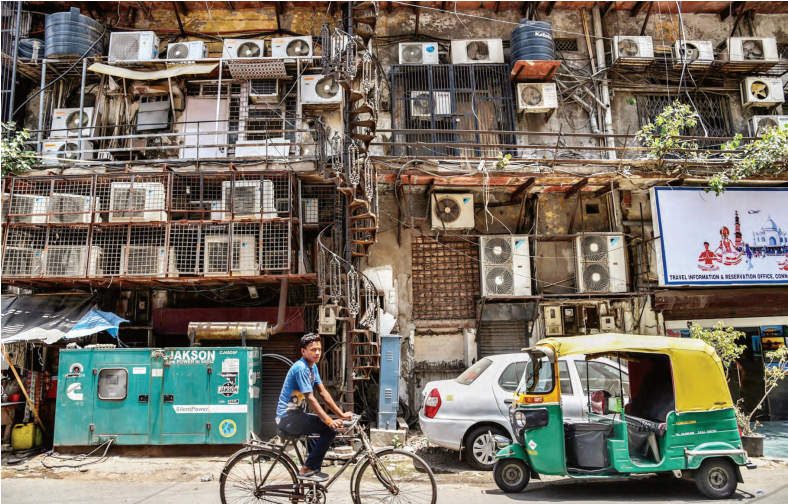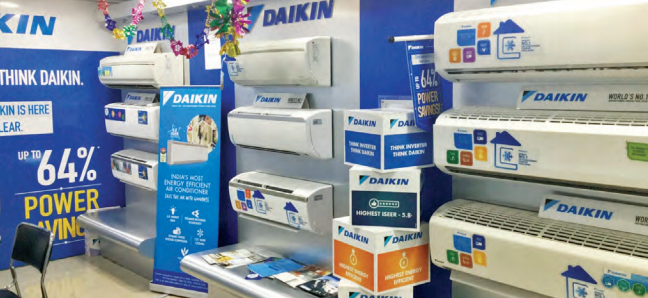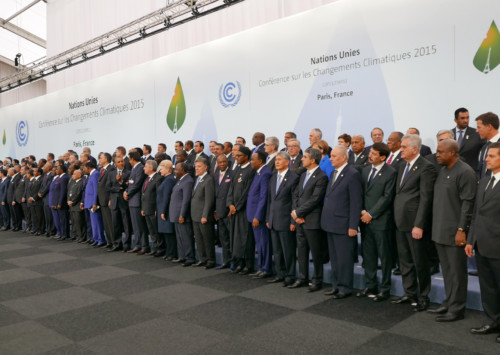Cooling the Hot and Crowded World
Biz@India
December 2018

The rapid spread of air conditioning around the world, mainly to counter the scathing summers that are getting even blistering due to global warming, has now become the new norm, and risks pushing the planet into a vicious, downward spiral.
The iron man and legendary leader Lee Kuan Yew, who transformed a tiny island of Singapore, with few natural resources to count on, into one of the wealthiest countries in the world, let it slip once that air conditioning was one of the key factors responsible for Singapore’s success.
“Air conditioning was a most important invention for us, perhaps one of the signal inventions of history. It changed the nature of civilization by making development possible in the tropics,” said Lee in one of his interviews. “The first thing I did upon becoming prime minister was to install air conditioners in buildings where the civil service worked. This was key to public efficiency,” he had added.
Air conditioners have worked the miracle for Singapore and other nations, but unfortunately these cooling devices that have become the new norm across most countries are themselves responsible for a significant amount of global warming!
The scale of the penetration may give comfort to some, but is dreadful to the atmosphere and hence, the planet. By 2050, there would be more than 9.5 billion cooling devices (fans, desert-evaporative coolers, and air conditioners), almost one for each inhabitant on earth and an increase of 2.5 times over the 3.6 billion today. The share of the air conditioners would rise from the current 1.6 billion to 5.6 billion by mid-century, which would be more than one air conditioner per two humans.
Each of these devices need energy, most of which comes from the power generation plants that burn fossil fuels and belch out greenhouse gases (GHGs), notably carbon dioxide (CO2).
As a country’s prosperity rises, so do the number of cooling devices as people, having taken care of the basic and essential needs, begin to spend on these ‘luxuries’; and as global warming rises, more is the need for space cooling and more is the energy needed to run cooling machines. More the need for energy, more is the fossil fuel needed to produce the energy in the power generation plants and consequently, more the GHGs emissions and furthermore is the global warming!
That sounds like a merry-go round except that there is absolutely nothing ‘merry’ about it. Even Singapore’s Lee would not have been gleeful about this prospect. It is literally a catastrophic downwards spiral for the health of our planet.
Since 1992, when the United Nations Earth’s Summit was held in Rio de Janeiro that gave birth to United Nations Framework Convention on Climate Change (UNFCCC), sales of air conditioners have jumped almost four-fold to 135 million units per year. The CO2 emissions from energy use in cooling have increased to 1.2 gigatonnes (GT) per year, equivalent to the total emissions of Japan. The electricity they use is now two and a half times the total electricity consumed in Africa and about 20 pc of all electricity used in buildings around the world.
A hot debate
Cooling has indeed become a hot topic in global warming discussions, not only because of the electricity it consumes, but the way it gets consumed. Air-conditioners work the most during the high temperature of the day and add to the ‘peak-load’ of power. After the office hours and with the cooler temperatures in the evenings, normally the consumption drops dramatically.

Since the birth of the UNFCCC, sales of air conditioners have jumped almost four-fold to 135 million units per year
Electricity demand hits its highest point during summers, primarily due to the widespread use of air conditioners. In fact, the grid has to work harder during the afternoons and part of the early evenings of the hottest summer days than it does at any other time of the year.
In the hot ambient temperature countries like in Middle East and also some parts of the US, and India, space cooling could represent more than 70 pc of peak residential electrical demand on extremely hot days. As the global warming proceeds, more and more ‘hot-spots’ are experiencing such surge in demands.
This peak load adds to the burden on the power generation during its busiest hours, meaning that during off-peak hours the additional capacity lies unutilised, increasing the cost of construction, operation and maintenance of power plants and transmission-distribution network. Such rising demand coupled with significant differences between peak and off-peak demand is creating a crisis in many countries for the utilities and also a major surge in GHG emissions.
Many analysts miss the point that it is not only high ambient temperature that drive the demand, it is also the humidity at not-so-high-temperature that drive the air-conditioning demand. Global warming raises the temperature of oceans and increases the humidity due to extra watervapour. It is no surprise that the lion’s share of the projected growth in energy use for space cooling by 2050 will come from emerging economies, with just three countries – India, China and Indonesia – each with a large coastal belt and urban population. These nations would contribute to half the global growth in demand for cooling energy.

Nearly all air-conditioners use global warming refrigerants like hydrofluorocarbons (HFCs) or hydrochlorofluoroCarbons (HCFCs)
Now comes the frightening ‘hot future of cooling’. Of the 2.8 billion people living in the hottest parts of the world, only eight pc currently possess ACs, compared to 90 pc ownership in the US and Japan. In business-as-usual scenario, it is difficult to imagine what would be the energy demand as well as GHG emissions when prosperity spreads across the hot and emerging economies as well.
The residential cooling load is unlikely to be controlled by the government policies as few are likely to be willing to sacrifice the well being of the family, unless there is convincing argument on adverse health impacts of cooling and the air pollution arising out of the CO2 emission.
Here comes the window of opportunity, if the government, business and civil society seize it. It is the opportunity that provides economic as well as ecological benefits. Nearly all air-Conditioners use global warming refrigerants like hydrofluorocarbons (HFCs) or hydrochlorofluorocarbons (HCFCs) or their blends that can impact cost of the air-conditioning and the climate change in two ways. One is through the use and leakage and second, emissions of GHGs arising out of energy used in running the equipment containing refrigerants. There are number of very low global warming refrigerants like hydrocarbons and ammonia that contribute to global warming mainly through the energy used for their air-conditioning equipment. They, however, have the negative side of their use i.e. flammability and toxicity respectively.
The HFCs and HCFCs are a family of refrigerant gases that have become predominant in recent years in refrigeration equipment with the phasing out of the manufacturing of chlorofluorocarbons (CFCs) in 2010, as a result of the uniquely successful multilateral environmental treaty, i.e. 1987 Montreal Protocol whose objective was to protect the stratospheric ozone layer.
Production and consumption of HCFCs would also be phased out under the Montreal Protocol over next few years. The HFCs, which are substitutes for CFCs and HCFCs were not included in the Montreal Protocol as they are harmless to the ozone layer. However, they are thousands of times more powerful GHGs than CO2.
In October 2016, 197 parties to the Montreal Protocol agreed on the extraordinary amendment to the Montreal Protocol to progressively phase down the production and use of the HFCs, also around the world. The amendment, called the Kigali Amendment as it was signed in the Rwandan capital, takes effect in different countries between 2019 and 2028, depending on national levels of development.
The start date for the phasing out of HFCs is January 1, 2019 for the developed countries while part of the developing countries including China, will have to start to cap their use by 2024. For a third group of developing countries with particularly hot climates – Bahrain, India, Iran, Iraq, Kuwait, Oman, Pakistan, Qatar, Saudi Arabia, and the United Arab Emirates – the start date is 2028.
Implementation of the Kigali Amendment is expected to prevent up to 80 giga tonnes CO2 equivalent of emissions by 2050, by way of preventing emission of HFCs during the time that air conditioners are operated. The most promising part of the Kigali Amendment is regarding the opportunities to improve the energy efficiency of the air-conditioning equipment and reduce the need for global warming refrigerants. Redesigning the cooling equipment, as part of the transition to climatefriendly refrigerants promises to avoid emission of more than 100 giga tonnes of CO2 equivalent globally from now to 2050, enhancing the the benefits of the HFCs phase down alone.
As per the Science Assessment Panel of the United Nations Environment Programme (UNEP) and the World Meteorological Organization (WMO), the full implementation of Kigali Amendment is projected to reduce future global average warming in 2100 due to the HFCs phase down alone up to 0.4°C. This is substantial in the context of the 2015 Paris Agreement, which aims to keep global temperature rise this century to well below 2°C above pre-industrial level. If one adds the benefit of enhanced energy efficiency of the cooling equipment, the warming could be contained by 0.8°C and go a long way in contributing to the realisation of Paris Agreement’s ambition of keeping the rise in global temperartures to 1.5°C above the pre-industrial levels.
In many ways, the little brother, Montreal Protocol, has paved the way, now to be seen if the big brother, Paris Climate Agreement, has will to go all the way.













